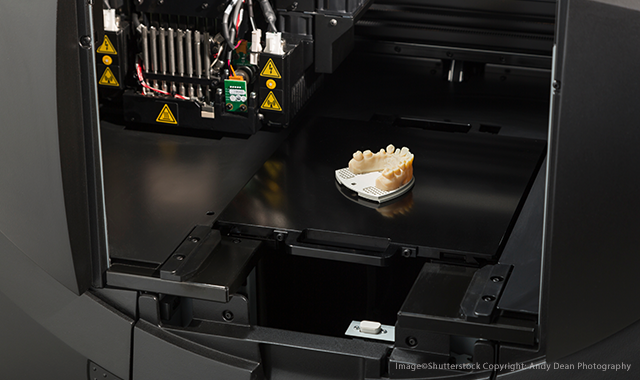Improving accessibility with 3D-printed dentures
With more patients requesting affordable options, monolithic dentures are growing in popularity - and the benefits go beyond just cost.

PMMA dentures with milled ceramic teeth are the bread and butter of the modern denturist. Using digital technologies to design the appliance and then finishing by hand is the kind of crossover between technology and artistry that would’ve made Leonardo da Vinci swoon. When it comes to looks and longevity, it’s hard to beat this combination.
But there’s demand for dentures that cost hundreds, not thousands, of dollars. In these cases, the basic ability to chew and the appearance of full dentition are the top priority. While monolithic dentures don’t feature the same esthetics or longevity as high-end implants, they can be printed with class Ia PMMA materials that are approved for up to one year of use.
Trending article: 6 materials lab techs need to know about
The birth of eco-dentures
Monolithic try-in dentures can be printed in around an hour and only cost a few dollars in materials. Originally conceived as a way to reduce the lead time on final dentures, prosthodontists have begun to expand their use-case. These 3D printed monolithic dentures can be printed using biocompatible certified, functional resins. Crucially, they can be stained to affect the realistic appearance of gingiva and teeth.
The benefits of monolithic printed dentures go beyond just cost. In the hands of a capable prosthodontist, a patient can have his or her dentition scanned in the morning and receive fully-cured eco-dentures by the end of the day. While labs excel at the mass production of high-quality dentures, the ability to fabricate in-house can significantly reduce the number of appointments that patients need to schedule to receive their dentures.
Monolithic roadmap
Currently, only a handful of 3D printers on the market can print PMMA monolithic dentures that are class Ia certified. By far the most economically priced, SprintRay’s line of 3D printers are one of the preferred machines of Lee Culp’s Sculpture Studios lab (they use them to print all their denture bases). These small desktop units can fabricate all manner of dental appliances but are particularly notable for being one of the only desktop printers that certifies and supports functional, FDA-approved resins for appliances such as monolithic dentures.
The accelerating rate of acceptance of 3D printing in dentistry puts these tools in the hands of more and more doctors. In the last few years, the experimental nature of this technology has kept it from exploding into a full-blown dental tool. But the new set of certified functional resins is rapidly shifting that paradigm. 3D printing has matured into a fully-fledged manufacturing process.
Reduced appointments, improved accessibility
But the benefits of 3D printed dentures go beyond just price. The digital design process is a large step forward in the workflow process, allowing prosthodontists and denturists more freedom and control over treatment planning. The ability to print a try-in denture in-house means that doctors can rapidly make adjustments to ensure perfect fit. If a problem is found with a printed try-in, then adjustments can be made to the CAD model and the patient can return the next day to retry the reprinted fitment.
This reduction in time spent waiting for fabrication and shipment reduces the inconvenience of multiple return appointments. While this may not seem significant to a prosthodontist with a clear understanding of how and why so many appointments are necessary, the reduction in appointments and lead times can set one office apart from others in the area.
Barriers and future prospects

Printing monolithic try-in and eco-dentures is a hot topic in prosthodontics, but the technology is still seen as new and unproven. Some knowledge of CAD/CAM software is required to fully design and plan digital dentures. There is also, of course, the basic cost of purchasing the printer hardware itself and the associated learning curve.
But despite these challenges, 3D printing is quietly but rapidly expanding into all aspects of digital dentistry. Lee Culp, a pioneer of esthetic prosthodontics, runs 3D printers in his lab all day to produce denture bases. His lab, Sculpture Studios, offers educational courses to help dentists expand their digital knowledge, and he’s not alone. Continuing education courses around the world are beginning to focus on the in-house production of dental appliances.
Read more: How to create esthetic results using digital dentistry
Conclusion
The costs of 3D printing in-office can seem high - but they don’t have to be. Desktop printers, such as the ones from SprintRay, sell for a fraction of the cost of intraoral scanners that precede them. For the digital prosthodontist interested in expanding his or her treatment offering and improving the accessibility of dentures, adding a printer to the clinic is an inexpensive way to stand out from the pack.
For those interested in seeing this process in-person, the International Denture Symposium is on the horizon. Along with dental 3D printer manufacturer SprintRay, renowned dental esthetics pioneer Lee Culp and practicing prosthodontist Nate Farley will be speaking on the subject of digital denture fabrication. As 3D printing continues to expand in dentistry, the offering of monolithic try-in and eco-dentures will allow patients who otherwise couldn’t afford treatment to get the appliances they need.